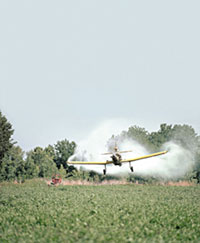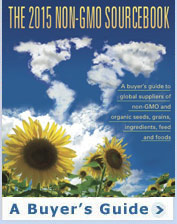Pesticide use increases with GM crops
Published: November 1, 2012
Category: GMO Food Environmental Risks

To access all the articles in this month's issue of The Organic & Non-GMO Report, SUBSCRIBE NOW.
GM crops increased pesticide use by 404 million pounds since 1996
A recently published study has found that pesticide use has increased with genetically modified crops, disproving claims by biotech proponents that GM crops reduce pesticide use.
The study was published by Washington State University research professor Charles Benbrook, who examined pesticide use on GM cotton, soybeans, and corn.
His findings are based on an exhaustive analysis of publicly available data from the US Department of Agriculture’s National Agriculture Statistics Service. Benbrook’s analysis is the first peer-reviewed, published estimate of the impacts of GM herbicide-tolerant (HT) crops on pesticide use.
Herbicide use increased from 1.5 million pounds to 90 million pounds
In the study, which appeared in the peer-reviewed journal Environmental Sciences Europe, Benbrook writes that the emergence and spread of glyphosate-resistant weeds is strongly correlated with the upward trajectory in herbicide use. Marketed as Roundup and other trade names, glyphosate is a broad-spectrum systemic herbicide used to kill weeds. Approximately 95% of soybean and cotton acres, and over 85% of corn, are planted to varieties genetically modified to be herbicide resistant.
“Resistant weeds have become a major problem for many farmers reliant on GM crops, and are now driving up the volume of herbicide needed each year by about 25 percent,” Benbrook said.
The annual increase in the herbicides required to deal with tougher-to-control weeds on cropland planted to GM cultivars has grown from 1.5 million pounds in 1999 to about 90 million pounds in 2011.
Overall, today’s major GM crops have increased overall pesticide use by 404 million pounds from 1996 through 2011 (527 million pound increase in herbicides, minus 123 million pound decrease in insecticides).
“Herbicide treadmill” for farmers
The biotechnology companies’ solution to herbicide resistant weeds is to introduce new GM crops that are tolerant to older, more toxic herbicides such as 2,4-D and dicamba. Benbrook has compared “this solution” to “pouring gasoline on a fire” because weeds will become resistant to these herbicides also.
“The USDA data is clear that herbicide usage is being pushed upward and the seed industry’s response to introduce more herbicide tolerant crops will make the problem worse and increase resistance. Herbicide tolerant crops are creating an onramp to a new high powered herbicide treadmill for farmers,” Benbrook says.
Increasing amounts of Bt toxin pose threats to environment
Benbrook also found that from 1996-2011 insect resistant genetically modified Bt corn and cotton crops reduced insecticide use by 123 million pounds, or about 28%. However, Benbrook says those gains are being reversed by insect resistance to the Bt toxin, which is causing farmers to use more insecticides.
In addition, biotech seed companies are increasing the amount of Bt toxin in GM Bt crops from one or two pounds per acre to nearly four. For example, so-called SmartStax GM corn produces 3.7 pounds of Bt per acre compared with 0.3 pounds of insecticides that would be used per acre without Bt corn. “3.7 pounds is a lot of Bt,” Benbrook says.
Benbrook says this escalation in the amount of toxins used poses environmental threats, especially since research has found that Bt can persist in soil and water for nearly six months after harvest.
“We should expect some unexpected things to happen in soils and possibly aquatic ecosystems (as a result of the increased amounts of Bt),” he says.
© Copyright The Organic & Non-GMO Report, November 2012




